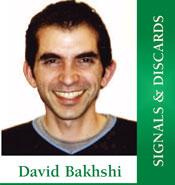(Originally published in English Bridge, April 2016)
David and Heather Bakhshi are well known bridge payers, with David playing regularly for England. Together, David and Heather have done the seemingly impossible...they have children who play bridge...and not just the odd game. Liam Sanderson(19) and Jasmine Bakhshi (14) have played for the English Junior teams many times with great success. How have they done it?






